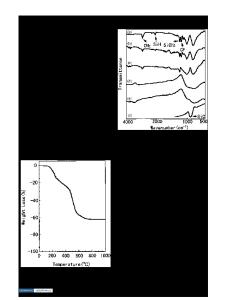Synthesis and Properties of Metal Phthalocyanines Containing Anthraquinone Chromophores
- PDF / 662,545 Bytes
- 4 Pages / 612 x 792 pts (letter) Page_size
- 33 Downloads / 357 Views
hesis and Properties of Metal Phthalocyanines Containing Anthraquinone Chromophores T. A. Rumyantsevaa,*, A. A. Alekseevaa, and M. A. Tkachenkoa a
Research Institute of Macroheterocyclic Compounds, Ivanovo State University of Chemistry and Technology, Ivanovo, 153000 Russia *e-mail: [email protected] Received April 21, 2020; revised April 21, 2020; accepted April 30, 2020
Abstract—Nucleophilic substitution of bromine in 4-bromophthalonitrile gave anthraquinone-substituted nitriles, sodium 2-{[4-(3,4-dicyanophenoxy)-9,10-dioxo-9,10-dihydroanthracen-1-yl]amino}-5-methylbenzenesulfonate and 4-[(2-hydroxy-9,10-dioxo-9,10-dihydroanthracen-1-yl)oxy]phthalonitrile, which were used to obtain the corresponding cobalt phthalocyanines by the nitrile method. Keywords: metal phthalocyanines, anthraquinone, substituted phthalonitriles, cobalt complexes
DOI: 10.1134/S107036322009011X Phthalocyanine dyes are not free from drawbacks such as a narrow range of colors and not always high dyeing performance. The widely known phthalocyanine dye Pigment Green 7 (C.I. 74260) contains 14‒15 chlorine atoms and features exceptionally high resistance to any effects; however, its coloring power is lower than that of Pigment Blue 15 (C.I. 74160). Pigment Green 7 is synthesized by fusion of Pigment Blue 15 with AlCl3 and NaCl at 165‒200°C. Replacement of some chlorine atoms by bromine gives a green pigment with a yellow tint. These pigments are among the most valuable ones and are used in printing and paint and varnish industries, as well as for the coloration of rubber, plastics, etc. [1, 2]. The color range of phthalocyanine pigments can be extended via introduction of substituents with their own chromophore system. In view of the above stated, herein we report the synthesis of cobalt phthalocyanines containing anthraquinone dye fragments and their physicochemical properties. Initially, we synthesized 4-bromophthalonitrile (1) [3], Acid Violet 43 (2), and alizarin (3) [4]. Nitriles 4 and 5 containing anthraquinone chromophores were prepared by reacting 4-bromophthalonitrile (1) with anthraquinone dyes 2 and 3 as nucleophiles (Nu) in DMF in the presence of potassium carbonate (Scheme 1). The reaction involved the 1-hydroxy group of 2 or 3 since 1-hydroxyanthraquinone is a much stronger nucleophile than 2-hydroxyanthraquinone [5]. Dimethylformamide was used as solvent, taking into account that the rate of
nucleophilic substitution in polar solvents is higher than in nonpolar solvents by 3‒5 orders of magnitude. Potassium carbonate is necessary to convert hydroxyanthraquinones to ArO‒ anion which is more nucleophilic than ArOH [6–9]. Compound 4 was isolated as a violet powder, and 5 was a yellow powder. Dinitriles 4 and 5 are soluble in aqueous alkali and organic solvents (DMF, DMS, chloroform, isopropyl alcohol). They were identified by elemental analyses and IR, electronic, and mass spectra. The IR spectra of 4 and 5, as well as of initial 4-bromophthalonitrile (1), showed absorption bands due to stretching vibrations of the cyano groups (223
Data Loading...











